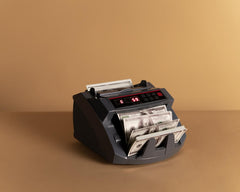Your cart is currently empty.

- Nov, 20 , 20
- 1 comment
How to Sanitize Dishes?
Contents
Now more than ever sanitizing everyday household objects has become a priority. This includes the pots and pans that we utilize. Although it is something that we do daily, many may not know how to sanitize dishes effectively as well as how to disinfect silverware and how to disinfect pots and pans. This article will provide a sanitizing solution for dishes, along with tips and precautions that will ensure your dishes are safely and sufficiently sanitized.
For more efficient cash management, it's essential to consider the latest options available for bill counting machines. This machine will help save your valuable time and minimize the probability of errors in your financial transactions.
Difference Between Sanitizing and Washing
There is a common misconception that washing dishes in hot soapy water is all that is necessary to disinfect dishes. This is not true. Most dishwashing liquids do not possess antibacterial properties and are therefore not adequate in eliminating all bacteria that might still be lingering on your dishes. Dishes and utensils looking clean is often not the same as them being clean. Although dishwashers are an ideal sanitizing solution, not everyone owns one.
Sanitization occurs when using either high heat or chemicals to eliminate germs. This may be done at home by the following methods:
- Making homemade chemical cleaning solutions - this can be done by using a teaspoon of unscented chlorine bleach, mixed with one gallon of water. Rinse dishes after soaking them in this solution for one minute and allow the dishes to air dry. Make sure to use gloves or utensils, not your bare hands, when removing dishes from the solution.
- Soaking dishes in hot water - Use boiling water at 170 °F for a minimum of 30 seconds. Monitor the temperature of the water with a thermometer and the length of the soak with a timer. After removing the dishes, allow them to air dry. Make sure to use gloves or utensils, not your bare hands, when removing dishes from the boiling water.
What Can Be Used to Sanitize Eating Utensils and How to Sterilize Metal
Utensils are often made up of detachable parts. Remove any parts like plastic or wooden handles, blades, and screens before washing. Wash the detached parts, utensils, and pots and pans in soapy, hot water. Steel wool or a stiff brush may be used to remove stubborn stains. After washing in the soapy water, rinse all dishes and cooking utensils in clean, clear water. Cleaning solutions such as the one mentioned above can be used. Place all objects in the solution, but be careful not to use hot water as it causes the bleach to evaporate, weakening the solution. Air dry the utensils using a sanitized dish rack.

Sanitization removes 99.9% of pathogens from a surface or object, while sterilization destroys all harmful germs. Metal utensils may be sterilized by using a chemical agent, steam, or boiling water to eradicate all microorganisms. This is mostly seen in healthcare facilities, as such extreme decontamination methods are needed in places like hospitals or laboratories, not household kitchens.
Using Specialized Equipment
Sterilizer machines are a great way to ensure your utensils and appliances are sufficiently disinfected from harmful germs and COVID-19 every time. They are suitable for both professional and personal use and are equipped with a variety of features. Disinfection cabinets are ideal for kitchen utensils, office supplies, and industrial products while multifunctional sterilizer machines are designed to disinfect numerous household items, documents, currency, and books.
Useful Tips and Precautions
The following sanitizing tips also include guidelines on how to sanitize dishes without a dishwasher:
- Use hot, not warm water - The correct water temperature is crucial when sanitizing dishes. Ensure that when hand washing dishes you use the hottest water possible. To avoid damage to your hands when washing, consider purchasing heat-resistant dishwashing gloves.
- Buy antibacterial dishwashing soap - Only a minority of dish soap is antibacterial. Pay close attention to the product label at the grocery store to ensure that you are purchasing the correct soap. Studies have shown that using a sanitizing solution and a water temperature of 75 degrees Fahrenheit effectively eliminates bacteria, except for milk found on glasses.
- Throw away your sponge! - Traditional dishwashing sponges are covered with bacteria. It is important to swap them out every week, or better yet, invest in a washing net or silicone scrubber to hand wash your dishes with.
- Use a dishwashing machine - The boiling water found in a dishwasher is far too hot for your hands to withstand when washing dishes. Water temperatures of above 140 degrees Fahrenheit are needed to kill bacteria and this can be easily achieved by your dishwasher.
- Sanitize your dishcloths - Dishcloths need to be washed every few days on the hottest water setting available on your washing machine followed by the hottest dryer setting to make sure that they are germ-free and you are not drying your sanitized dishes with a dirty cloth. You may also air dry your dishes if you are worried about any contamination from drying equipment.
Precautions are necessary when sanitizing dishes as boiling water and chemical solutions may be dangerous if handled incorrectly. Ensure that you always use gloves when removing dishes and utensils from chemical solutions and boiling water.
Conclusion
Dishes are a tedious, yet necessary, part of everyday life. To ensure a hygienic household environment and the prevention of food cross-contamination, it is vital to use proper sanitization methods when washing your dishes. There are a variety of sanitization methods available, from inexpensive homemade options to advanced sterilizer machines - ensuring that your cutlery, tableware, documents, and other household objects are free from harmful germs.
Search
Custom Menu
Recent Post
Archive
- April 2022
- September 2021
- August 2021
- July 2021
- March 2021
- February 2021










1 comment
Jennifer
Sep 27, 2022 at 04:19A little trick I do since I don’t have a working dishwasher is to go ahead and put the dishes and silverware into the dish drain. Put the whole thing in the sink, then gently pour boiling hot water from a tea kettle. Let them sit for a few minutes, then put them away.